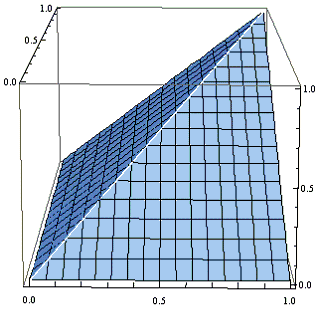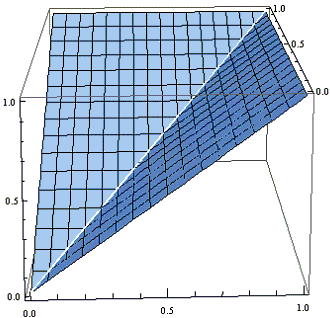Averaging Raindrops, Part 2
Scott E. Brodie
11/11/2010
We have shown that if x and y are independent random variables ranging uniformly over the interval from 0 to 1 (like the x- and y-coordinates of raindrops which land on the unit square), the average of the minimum of x and y is given by the volume of the pyramid whose base is the unit square, and whose apex is the point

Can we obtain a similar evaluation for the average of the maximum of x and y?
No problem!
Here is a plot of the function max(x, y) over the unit square:

Careful inspection of this surface shows that it is the upper boundary of the union of two pyramids, each congruent to the pyramid in the first figure, but oriented so that its base is one of the vertical faces of the unit cube, and the vertex is at the origin
We may verify our exploration algebraically. Quite obviously
Using the additivity of the mathematical expectation,
We also get
confirming the geometric derivation.
Geometric Probability
- Geometric Probabilities
- Are Most Triangles Obtuse?
- Barycentric Coordinates and Geometric Probability
- Bertrand's Paradox
- Birds On a Wire (Problem and Interactive Simulation)
- Buffon's Noodle Simulation
- Averaging Raindrops - an exercise in geometric probability
- Averaging Raindrops, Part 2
- Rectangle on a Chessboard: an Introduction
- Marking And Breaking Sticks
- Random Points on a Segment
- Semicircle Coverage
- Hemisphere Coverage
- Overlapping Random Intervals
- Random Intervals with One Dominant
- Points on a Square Grid
- Flat Probabilities on a Sphere
- Probability in Triangle
|Contact| |Front page| |Contents| |Probability|
Copyright © 1996-2018 Alexander Bogomolny
71550720
